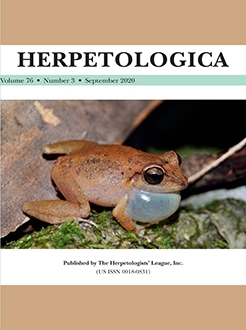We studied nesting and reproductive ecology of critically endangered Gharials (Gavialis gangeticus) in the Narayani and Rapti rivers as well as ex situ breeding facilities in the Chitwan National Park in Nepal from 2001 to 2017. We located a total of 151 Gharial nests over 17 yr in sand banks along the Narayani (n = 94 nests) and Rapti (n = 57 nests) rivers and brought these nests to ex situ breeding facilities where eggs were artificially incubated. The number of nests (mean, 8.9/yr) showed an increasing trend over the years between 2001 and 2017. Nesting occurred within a narrow window of time (mean oviposition date, March 31) with onset of nesting varying by a maximum of 7 d between years (22–29 March). Similarly, eggs hatched from the first week of June through the first week of July (mean, June 15) after a mean incubation period of 76 d, with varying hatching success (mean, 60.5%). We did not find any correlation between incubation period and hatching success. Mean oviposition and hatching date both differed significantly among years probably due to annual variation in nesting cues. We found a significant positive correlation between clutch size and proportion of infertile eggs. Mean clutch size (32.3) and proportion of infertile eggs (mean, 10 eggs) both were significantly higher in clutches in Narayani than in Rapti; however, hatching success was significantly higher in clutches in Rapti. On average, nests had a circumference of 102.3 cm and a depth of 48.5 cm. Mean midriver depth (2.21 m) did not vary over the years but was higher in Narayani than in Rapti; however, mean depth of water nearest to the nest (1.15 m) varied among years and was higher in Rapti. Nests in Narayani were farther from the water's edge than nests in Rapti, suggesting local adaption of female Gharials to prevent flooding of nests owing to severe flooding in the Narayani. This is the first study to present long-term scientific information on nesting and reproduction of Gharials in Nepal. Such information will be pivotal in designing and implementing conservation programs as well as optimizing ex situ breeding practices for Gharials in Nepal.
How to translate text using browser tools
9 September 2020
Nesting Ecology of Gharials (Gavialis gangeticus): Implications from In Situ and Ex Situ Conservation Programs in Chitwan National Park, Nepal
Bed Khadka,
Ashish Bashyal,
Kishor P. Luitel,
Ram C. Kandel
ACCESS THE FULL ARTICLE

Herpetologica
Vol. 76 • No. 3
September 2020
Vol. 76 • No. 3
September 2020
clutch
Crocodylians
Gharial nests
hatching success
incubation




